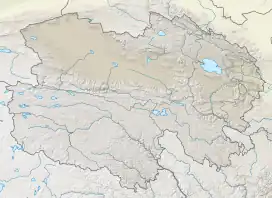| Dabiele Lake | |
|---|---|
| 大别勒湖 (Chinese) | |
 | |
 Dabiele Lake | |
| Location | Golmud County Haixi Prefecture Qinghai Province China |
| Coordinates | 36°54′20″N 94°23′28″E / 36.90556°N 94.39111°E |
| Type | Endorheic saline lake |
| Primary inflows | Tuolahai River Qingshui River |
| Basin countries | China |
| Surface area | 0–7.38 km2 (0.00–2.85 sq mi) |
| Surface elevation | 2,676.6 m (8,781 ft) |
| Dabiele Lake | |||||||||
|---|---|---|---|---|---|---|---|---|---|
| Traditional Chinese | 大別勒湖 | ||||||||
| Simplified Chinese | 大别勒湖 | ||||||||
| |||||||||
| Bieletan | |||||||||
| Traditional Chinese | 別勒灘 | ||||||||
| Simplified Chinese | 别勒滩 | ||||||||
| |||||||||
| Dabieletan | |||||||||
| Traditional Chinese | 大別勒灘 | ||||||||
| Simplified Chinese | 大别勒滩 | ||||||||
| |||||||||
Dabiele Lake, also known by other names, is an ephemeral lake in the southwestern Qarhan Playa north of Golmud in the Haixi Prefecture of Qinghai Province in northwestern China. It is fed by the Tuolahai and Qingshui Rivers from the Kunlun Mountains to the south. Like the other lakes of the surrounding Qaidam Basin, it is extremely saline; like the other lakes in the Bieletan subbasin, it is rich in lithium.
Names
The da at the beginning of the name is the pinyin romanization of the Chinese word for "big" or "greater", distinguishing it from nearby Xiaobiele Lake ("Little" or "Lesser Biele Lake"). Dabiele is also known as Bieletan or Dabieletan,[1] from a Chinese word used for both beaches and muddy riverbanks.
Geography
Dabiele Lake is an ephemeral salt lake[2] in the Bieletan subbasin[3][4] on the southwestern edge of the Qarhan Playa at an elevation of 2,676.6 m (8,781 ft).[5] It lies between Suli and Xiaobiele Lakes. It is usually about 7.38 km2 (2.85 sq mi) wide.[5] It is fed from the south by the Tuolahai (托拉亥河, Tuōlāhài Hé) and Qingshui Rivers[6] (清水河, Qīngshuǐ Hé). Its depth usually does not exceed 1 m (3 ft 3 in).[1]
Geology
Dabiele's position at the south end of the playa means that its waters are relatively less influenced by the concentrated mineral springs along the playa's northern boundary.[7] As with Xiaobiele, it is nonetheless nearly saturated with calcite, anhydrite, halite, and (importantly) carnallite,[8] which is processed to produce potash for potassium-rich fertilizers and other uses.
The Bieletan subbasin as a whole—inclusive of Suli, S. Suli, and Xiaobiele—is also the richest source of brine lithium in China, with an estimated store of 7.74 million metric tons (8.53 million short tons) of lithium chloride.[9] The lithium derives from hot springs located near Mount Buka Daban which now feed the Narin Gol River or Hongshui River[10] (t 紅水河, s 红水河, Hóngshuǐ Hé) that flows into East Taijinar Lake.[11] In the past, however, the springs lay within the "Kunlun" paleolake which until about 30,000 years ago produced a river which flowed north into a broad alluvial fan feeding the "Qarhan" paleolake in the Sanhu area.[12] Bieletan's lithium came both from deposits directly flowing into the area at the time and continuing contributions from the Urt Moron and other rivers arising in and flowing through the former alluvial plain.[13]
See also
References
Citations
- 1 2 Yu & al. (2001), p. 62.
- ↑ Yu & al. (2013), p. 176.
- ↑ Yu & al. (2013), p. 177.
- ↑ Du & al. (2018), pp. 2–3.
- 1 2 Zheng (1997), p. 15
- ↑ Du & al. (2018), p. 2.
- ↑ Spencer & al. (1990), pp. 398–399.
- ↑ Spencer & al. (1990), p. 405.
- ↑ Yu & al. (2013), pp. 171–172.
- ↑ Yu & al. (2013), pp. 177–178.
- ↑ Yu & al. (2013), p. 173.
- ↑ Yu & al. (2013), pp. 172–173.
- ↑ Yu & al. (2013), p. 182.
Bibliography
- Du Yongsheng; et al. (April 2018), "Evalutation of Boron Isotopes in Halite as an Indicator of the Salinity of Qarhan Paleolake Water in the Eastern Qaidam Basin, Western China", Geoscience Frontiers, vol. 10, No. 1, Beijing: China University of Geosciences, pp. 1–10, doi:10.1016/j.gsf.2018.02.016.
- Spencer, Ronald James; et al. (1990), "Origin of Potash Salts and Brines in the Qaidam Basin, China" (PDF), Fluid-Mineral Interactions: A Tribute to H.P. Eugster, Special Publication No. 2, Geochemical Society.
- Yu Ge; et al. (2001), Lake Status Records from China: Data Base Documentation (PDF), MPI-BGC Tech Rep, No. 4, Jena: Max Planck Institute for Biogeochemistry.
- Yu Junqing; et al., "Geomorphic, Hydroclimatic, and Hydrothermal Controls on the Formation of Lithium Brine Deposits in the Qaidam Basin, Northern Tibetan Plateau, China" (PDF), Ore Geology Reviews, vol. No. 50, Amsterdam: Elvesier, pp. 171–183, doi:10.1016/j.oregeorev.2012.11.001.
- Zheng Mianping (1997), An Introduction to Saline Lakes on the Qinghai–Tibet Plateau, Dordrecht: Kluwer Academic Publishers, ISBN 9789401154581.